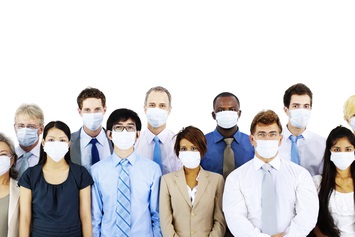More studies are needed to understand how to prevent and handle infectious disease outbreaks in the workplace, according to the Centers for Disease Control and Prevention’s (CDC) National Institute for Occupational Safety and Health (NIOSH).
Researchers only could find 67 medical journal articles and 7 NIOSH Health Hazard Evaluation reports on 66 investigations of workplace outbreaks between 2006 and 2015.
The outbreaks reviewed included:
- Ebola infections of healthcare workers in U.S. hospitals,
- HIV transmission among adult film performers, and
- Measles infection of a Customs and Border Protection officer at an airport.
Past Cases Don’t Predict Future Outbreaks
The outbreaks between 2006 and 2015 appeared to be concentrated in specific industries and occupations, especially in the healthcare industry and among laboratory, animal, and public service workers.
However, NIOSH concluded other industries and workers may be at risk. The researchers could not be certain of which industries or workers could be vulnerable to future infections.
Review Published in CDC Journal
NIOSH’s review article was published in CDC’s Emerging Infectious Diseases journal. NIOSH researchers found several workplace clusters involving emerging and re-emerging diseases that included:
- Anthrax,
- Ebola,
- Lymphocytic choriomeningitis,
- Norovirus, and
- Plague (Yersinia pestis).
Workers Commonly Affected
Because their work often brings them in contact with people who are ill, teachers and public service workers (firefighters, emergency medical technicians, and police and correctional officers) may acquire viral respiratory infections, including influenza and measles.
Healthcare workers are at risk for airborne infections like influenza and tuberculosis, as well as percutaneously transmitted HIV infections from patients.
Some diseases can be transmitted between animals and workers. Farmworkers, as well as workers in poultry processing plants and slaughterhouses are at risk for infection. NIOSH even reviewed a study of workers at a marine mammal rehabilitation center who became infected with sealpox.
Workers in food service may become infected in the workplace and then transmit diseases like salmonella and norovirus to the general public.
Fungal respiratory infections can happen to workers in outdoor occupations in the hot, dry conditions of the U.S. Southwest (Arizona, California, Nevada, New Mexico, and Texas). Outbreaks of Valley Fever (coccidioidomycosis) have occurred among construction and outdoor film production workers in California. Between 2011 and 2014, a total of 44 cases of Valley Fever were diagnosed in construction workers building solar power farms.
Employers’ Precautions
NIOSH has a hierarchy of controls it recommends that employers use to prevent workplace injuries and illnesses. Those measures, from most to least effective, are:
- Elimination (physically removing a hazard),
- Substitution (replacing a hazard),
- Engineering controls (isolating people from a hazard),
- Administrative controls (changing the way people work), and
- PPE (protecting workers with personal protective equipment).
While PPE is the most visible or commonly used control in hospitals and other healthcare settings, it is the least effective. For example, double-gloving is recommended for healthcare workers who treat Ebola patients; but there isn’t strong evidence yet of its effectiveness.
NIOSH recommended healthcare employers develop comprehensive vaccination policies. Healthcare workers should be immunized for vaccine-preventable diseases, such as:
- Chickenpox (varicella),
- Hepatitis B,
- Influenza,
- Measles,
- Mumps,
- Rubella, and
- Whooping cough (pertussis).
It can be difficult for an employer to prevent or handle an outbreak. Employers, labor unions, regulatory agencies, trade associations, workers, and the general public can have competing priorities. Expense and time constraints can also be barriers to implementing solutions to outbreaks.
However, NIOSH recommends developing a strong safety culture in all workplaces. Addressing workplace infectious disease outbreaks may take a multidisciplinary approach, involving engineers, epidemiologists, industrial hygienists, and physicians.


